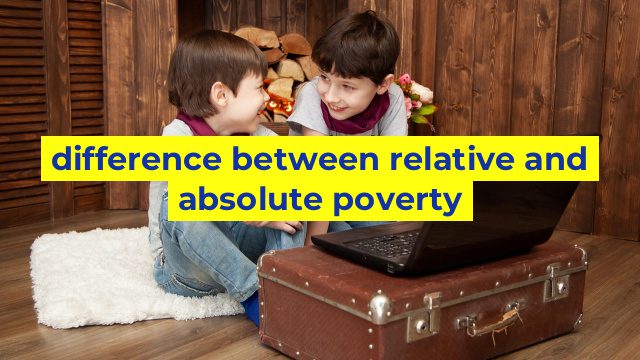The Distinction between Relative and Absolute Poverty
What is Relative Poverty?
Relative poverty is the measure of poverty in relation to the economic status of the society in which an individual lives. It is measured by the income and standard of living of the people in the society. In other words, it focuses on the level of disadvantage that a person may endure because of having less income and resources in comparison to the average income of the society.
Thus, if the average income of society is high, then the level of poverty is higher in case an individual has lower than that average amount of income. In general, there is no fixed level of income that determines the poverty line for relative poverty, rather it relies upon the living standard of the people in a particular society. The higher the living standards of a society are, the more difficult it is for the poor to meet those standards.
What is Absolute Poverty?
Absolute poverty is the measure of poverty based on the universal standard of basic human needs, which includes food, clothing, shelter, and health care. It is a situation where a person lacks the capacity to afford the basic necessities of life.
The threshold for absolute poverty is generally set by the World Bank, which uses the global poverty line to determine the standard of living. According to the World Bank, an individual who lives with less than $1.90 per day is considered to be living in absolute poverty conditions. However, this threshold can vary in different regions of the world, depending on factors such as local living standards and currency exchange rates.
The Key Difference between Relative and Absolute Poverty
The primary distinction between relative and absolute poverty is that absolute poverty focuses on the basic necessities of life, while relative poverty considers the standard of living of the surrounding society. Absolute poverty is an unambiguously poor state, while relative poverty is a relative disadvantage. Thus, the poor in developed countries may have more access to resources than those in poor countries, but still be considered poor due to their respective societal standards.
In conclusion, while both absolute and relative poverty can cause significant economic hardship, the difference between these two types of poverty resides in the way poverty is measured. Understanding the differences between these two types of poverty is crucial to developing appropriate strategies to tackle it. Nevertheless, both are challenging issues that require well-crafted social welfare policies and programs to be resolved.
Table difference between relative and absolute poverty
| Relative Poverty | Absolute Poverty |
|---|---|
| Refers to the condition where an individual is unable to afford goods and services that are considered essential in their society. | Refers to the condition where an individual is unable to afford the basic requirements for survival such as food, shelter, and clothing. |
| Income inequality and poverty rates are compared to the general population in a specific country or region. | The inadequate level of resources required to sustain life is the primary concern. |
| Relative poverty is measured using the poverty line or threshold, which is typically calculated as a percentage of the median income in a given country. | Absolute poverty is measured using a fixed standard of living, such as the minimum amount of calories per day required for a person’s survival. |
| It focuses on the social exclusion caused by poverty and the inability to participate in society in a meaningful way. | It is concerned with the physical and health risks associated with extreme deprivation and lack of access to critical resources. |
| Relative poverty is typically found in developed countries and is often addressed through policies such as social welfare programs and progressive taxation. | Absolute poverty is a more widespread phenomenon found in developing countries and is often addressed through foreign aid and development programs. |
